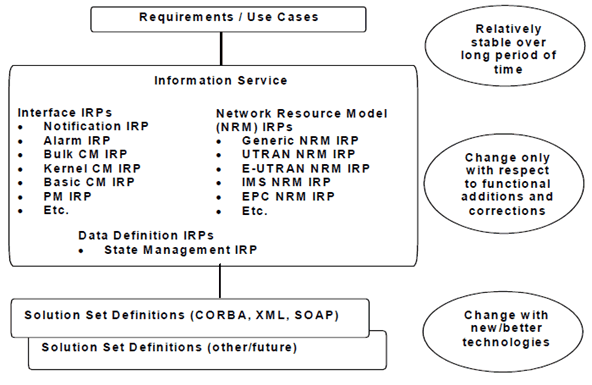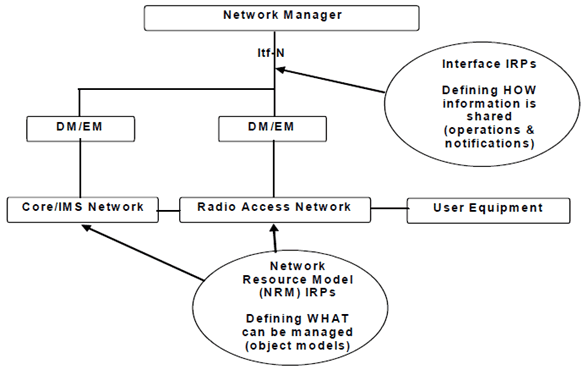Content for TS 32.103 Word version: 18.0.0
3 Definitions and abbreviations
3.1 Definitions
3.2 Abbreviations
4 IRP Framework
4.1 Introduction
4.2 IRP Framework Highlights
4.3 IRP related High-level Requirements & Architecture Specifications
4.4 Converged Management and IRPs
3 Definitions and abbreviations p. 15
3.1 Definitions p. 15
For the purposes of the present document, the terms and definitions given in TR 21.905, TS 32.150, TS 32.101 and the following apply
Data Definition IRP:
3GPP publishes IRP specifications relating to commonly used data definitions that can be imported for use by Interface IRP and/or NRM IRP. This term represents all such specifications. An example of a Data Definition IRP is the State Management IRP (28.624 [4], 28.625 [5], 28.626 [6], etc).
Integration Reference Point (IRP):
An architectural concept that is described by a set of specifications for definition of a certain aspect of a management interface, comprising a Requirements specification, an Information Service specification, and one or more Solution Set specifications.
Interface IRP:
3GPP publishes a number of IRP specifications each of which is related to a set of operations and notifications for a specific telecom management domain such as alarm management, configuration management, etc. Interface IRPs also contain definitions of Support IOCs. This term represents all such specifications. An example of an Interface IRP is the Basic CM IRP (the set of TSs 32.601 [7], 32.602 [8], 32.603 [9], etc.).
IRPAgent:
Encapsulates a well-defined subset of network (element) functions. It interacts with IRPManagers using one or more IRPs. From the IRPManager's perspective, the IRPAgent behaviour is only visible via the IRP(s).
Information Service (IS):
an IRP Information Service describes the information related to the entities (either network resources or support objects) to be managed and the way that the information may be managed for a certain functional area (e.g. the Alarm IRP Information Service in the fault management area). Information Services are defined for all IRPs.
IRPManager:
Models a user of IRPAgent(s) and it interacts directly with the IRPAgent(s) using IRP(s). Since the IRPManager represents an IRPAgent user, it gives a clear picture of what the IRPAgent is supposed to do. From the IRPAgent perspective, the IRPManager behaviour is only visible via the IRP.
Network Resource Model (NRM):
An Information Service describing Information Object Classes representing the manageable aspects of network resources, e.g. an RNC or NodeB.
NRM IRP:
3GPP publishes a number of IRP specifications each of which is related to a particular NRM (Network Resource Model) as defined in TS 32.101. NRM IRPs do not define any operations or notifications. This term represents all such specifications. Note: In some NRM IRP titles, for historic reasons, they are named "…network resources IRP"). An example of an NRM IRP is the Generic NRM IRP (28.621 [10], 28.622 [11], 28.623 [12], etc.).
Solution Set (SS):
contains a mapping of the IRP Information Service (IS) defined entities (that are technology-agnostic) to technology specific termed entities. It does not contain specification of the entities' semantics. The semantics can be found in the corresponding IS. It is noted that one IS can be mapped to one or several SSs.
3.2 Abbreviations p. 16
For the purposes of the present document, the abbreviations given in TR 21.905 and the following apply. An abbreviation defined in the present document takes precedence over the definition of the same abbreviation, if any, in TR 21.905.
AN
Access Network
CN
Core Network
FMC
Fixed Mobile Convergence
FNIM
Federated Network Information Model
IF
Interface
IRP
Integration Reference Point
IS
Information Service
NFV
Network Function Virtualization
NRM
Network Resource Model
PM
Performance Management
SS
Solution Set
UIM
Umbrella Information Model
WLAN
Wireless Local Area Network
4 IRP Framework p. 17
4.1 Introduction p. 17
For the purpose of management interface development 3GPP has developed an interface concept known as Integration Reference Point (IRP) to promote the wider adoption of standardized management interfaces in telecommunication networks. The IRP concept and associated methodology employs model-driven development, protocol and technology neutral modelling methods as well as protocol specific solution sets to achieve its goals.
IRP Framework and Methodology related 3GPP specifications:
- TS 32.150: Integration Reference Point (IRP) Concept and definitions
- TS 32.153: IRP technology specific templates, rules and guidelines
- TS 32.154: Backward and Forward Compatibility Concept and definitions
- TS 32.155: Requirements template
- TS 32.156: Fixed Mobile Convergence (FMC) Model repertoire
- TS 32.157: IRP Information Service (IS) template
4.2 IRP Framework Highlights p. 18
4.2.1 IRP Concept p. 18
IRP specifications are specified using a 3-level approach: Requirements, IS-level and SS-level.

Figure 4.2-1: The IRP 3-level specifications approach combined with the three IRP categories
(⇒ copy of original 3GPP image)
(⇒ copy of original 3GPP image)
Requirements-level:
The "Requirements-level" intends to provide conceptual and use cases definitions for a specific management interface aspect as well as defining subsequent requirements for this IRP.
IS-level:
The "IS-level" provides the technology independent specification of an IRP.
SS-level:
The "SS-level" finally provides the mapping of IS definitions into one or more technology-specific Solution Sets. This concept provides support for multiple interface technologies as applicable on a vendor and/or network type basis and also enables accommodation of future interface technologies - without the need to redefine requirements and IS-level definitions.
4.2.2 Relationships between IRPs p. 19
There are three categories of IRP specifications:
- Interface IRPs
- NRM IRPs
- Data Definition IRPs
- Some Interface IRPs and NRM IRPs are used together. Such Interface IRPs operate on entities modelled by NRM IRPs. For example, operations defined in Basic CM IRP are used together with E- UTRAN NRM IRP to support E-UTRAN configuration management function.
- Interface IRPs are network/radio technology independent and can operate on entities modelled by NRM IRPs of different network technologies. For example, operations defined in Basic CM IRP are used together with E- UTRAN NRM IRP or UTRAN NRM IRP to support E- UTRAN or UTRAN configuration management functions.
- Interface IRPs are Converged Management ready (e.g. support management of fixed and/or mobile) and can operate on modelled mobile and/or fixed network entities.
- A Data Definition IRP provides common data definitions, referenced by specifications of Interface IRPs and NRM IRPs.

4.2.3 IRP Development Principles p. 20
NRM IRP Extendibility:
Enabling Technology, Organizational & Vendor-specific NRM extensions via
- Rule-based NRM Extensions (e.g. Sub-classing)
- vsDataContainer
Enabling: wide applicability, phased introduction capabilities & broad industry adoption (not just for wireless) via
- Flexible use of qualifiers "mandatory", "optional", "conditional" for operation, notifications and/or parameters
- NRM/Technology-neutrality & avoiding competing procedures
4.2.4 IRP Specification Structure p. 20
32-series IRPs follow a uniform specification structure:
- xx1: xyz IRP Requirements
- xx2: xyz IRP IS
- xx3: xyz IRP CORBA SS (merged into xx6 after R9)
- xx4: xyz IRP CMIP SS (retired after R6)
- xx5: xyz IRP XML Definitions (applicable for NRM's & notification emitting IRPs - merged into xx6 after R9)
- xx6: xyz IRP SS (since Rel-10, containing all technology specific Solution Set definitions)
- xx7: xyz IRP SOAP SS (merged into xx6 after R9)
- 28.3xx: Interface IRP specifications.
- 28.611-28.616 EPC and non-3GPP access interworking system NRM IRP
- 28.620-28.649: Common/Generic NRM IRPs.
- 28.650-28.699: Access Network related NRM IRPs.
- 28.700-28.729: CN-related NRM IRPs.
- 28.730-28.749: Transport-related NRM IRPs.
- 28.750-28.769: Service-related NRM IRPs.
- 28.770-28.799: reserved for future topic NRM IRPs.
4.2.5 Void
4.3 IRP related High-level Requirements & Architecture Specifications p. 21
The IRP Framework has been developed in response to management requirements documented in the following specifications:
- TS 32.101: Principles and high level requirements
- TS 32.102: Architecture
- TS 32.107: Fixed Mobile Convergence (FMC) Federated Network Information Model (FNIM)
- TS 32.111-1: 3G fault management requirements
- TS 32.140, SuM requirements
- TS 32.141: SuM architecture
- TS 32.300: Name convention for Managed Objects
- TS 32.401: PM Concept and requirements
- TS 32.500: SON Concepts and requirements
- TS 32.511: ANR management Concepts and requirements
- TS 32.521 [29]: Self-optimization Concepts and requirements
- TS 32.541: Self-healing Concepts and requirements
- TS 32.551: Energy Saving Management (ESM) Concepts and requirements
- TS 32.600: CM Concept and high-level requirements
4.4 Converged Management and IRPs |R11| p. 22
As outlined in previous sections, 3GPP Interface IRPs are network-technology-independent, and therefore can be utilized for the management of various network technologies.
To further ease converged management (the common management of multiple network technologies) and to address the need for OPEX reduction, 3GPP together with other industry organizations (i.e. NGMN and TM Forum) developed jointly the following specifications:
-
Fixed Mobile Convergence (FMC) Federated Network Information Model (FNIM) (published in 3GPP as TS 32.107)
- Defining conceptually the federated network information model and the relationships between participating models (see also section 5.5 of TS 32.101).
-
FMC FNIM Umbrella Information Model (UIM) (published in 3GPP as TS 28.620)
- Providing abstract definitions of information objects applicable across Domain/Technology-specific Concrete Models.
-
Fixed Mobile Convergence (FMC) Model repertoire (published in 3GPP as TS 32.156)
- Defining meta definitions for models supporting converged management.
-
Fixed Mobile Convergence (FMC) 3GPP / TM Forum Concrete Model Relationships and Use Cases
- Proposing the specific structure of model and realisation of that structure across 3GPP and TM Forum by taking advantage of current TM Forum transport-oriented model work (SID, MTNM/MTOSI) as well as current 3GPP SA5 mobile-oriented model work (NRM IRPs etc.).